Fokker Dr.I Triplane
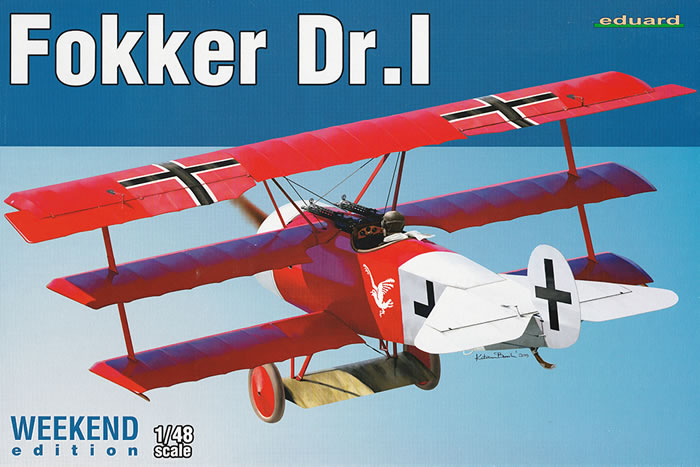
Eduard Weekend Edition, 1/48 scale
S
u m m a r y |
| Catalogue Number and Price: |
Eduard Kit No. EDK8487 -Fokker Dr.I Triplane Weekend Edition
USD$22.95 plus shipping available online from Eduard
GBP£13.20 EU Price (£11.00 Export) plus shipping available online from Hannants
|
| Scale: |
1/48 |
| Contents and Media: |
3 grey injection moulded sprues containing 78 parts (8 not used), 1 sheet of decals and a 12 page instruction booklet . |
| Review Type: |
Re-released with new schemes. |
| Advantages: |
A kit with crisp yet subtle moulding with good level of detail, Eduard’s usual high quality instructions. It has 2 colourful schemes offered. For a WWI aircraft, there is very little rigging to do. |
| Disadvantages: |
Undercarriage struts are too long – nose sits high. |
| Conclusion: |
A chance to add a well detailed, yet fairly simple construction kit with colourful WWI German schemes. A nice kit! |
Reviewed by David Couche

The Fokker Dr.I (Dreidecker, "triplane" in German), often known simply as the Fokker Triplane, was a World War I fighter aircraft built by Fokker-Flugzeugwerke. The Dr.I saw widespread service in the spring of 1918. It became famous as the aircraft in which Manfred von Richthofen gained his last 19 victories, and in which he was killed on 21 April 1918.
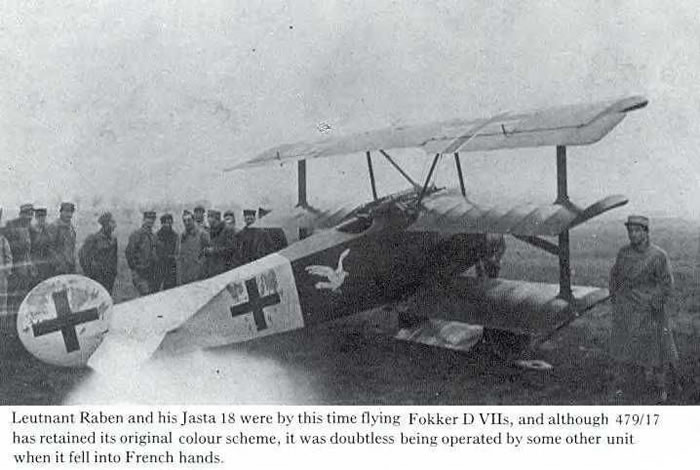
In February 1917, the Sopwith Triplane began to appear over the Western Front. Despite its single Vickers machine gun armament, the Sopwith swiftly proved itself superior to the more heavily armed Albatros fighters then in use by the Luftstreitkräfte. In April 1917, Anthony Fokker viewed a captured Sopwith Triplane while visiting Jasta 11. Upon his return to the Schwerin factory, Fokker instructed Reinhold Platz to build a triplane, but gave him no further information about the Sopwith design. Platz responded with the V.4, a small, rotary-powered triplane with a steel tube fuselage and thick cantilever wings, first developed during Fokker's government-mandated collaboration with Hugo Junkers. Initial tests revealed that the V.4 had unacceptably high control forces resulting from the use of unbalanced ailerons and elevators.
Instead of submitting the V.4 for a type test, Fokker produced a revised prototype designated V.5. The most notable changes were the introduction of horn-balanced ailerons and elevators, as well as longer-span wings. The V.5 also featured interplane struts, which were not necessary from a structural standpoint, but which minimized wing flexing. On 14 July 1917, Idflieg issued an order for 20 pre-production aircraft. The V.5 prototype, serial 101/17, was tested to destruction at Adlershof on 11 August 1917.
The first two pre-production triplanes were designated F.I, in accord with Idflieg's early class prefix for triplanes. These aircraft, serials 102/17 and 103/17, were the only machines to receive the F.I designation[10] and could be distinguished from subsequent aircraft by a slight convex curve of the tailplane's leading edge. The two aircraft were sent to Jastas 10 and 11 for combat evaluation, arriving at Markebeeke, Belgium on 28 August 1917.

Richthofen first flew 102/17 on 1 September 1917 and shot down two enemy aircraft in the next two days. He reported to the Kogenluft (Kommandierender General der Luftstreitkräfte) that the F.I was superior to the Sopwith Triplane. Richthofen recommended that fighter squadrons be reequipped with the new aircraft as soon as possible. The combat evaluation came to an abrupt conclusion when Oberleutnant Kurt Wolff, Staffelführer of Jasta 11, was shot down in 102/17 on 15 September, and Leutnant Werner Voss, Staffelführer of Jasta 10, was killed in 103/17 on 23 September.
The remaining pre-production aircraft, designated Dr.I, were delivered to Jasta 11. Idflieg issued a production order for 100 triplanes in September, followed by an order for 200 in November. Apart from the straight leading edge of the tailplane, these aircraft were almost identical to the F.I. The primary distinguishing feature was the addition of wingtip skids, which proved necessary because the aircraft was tricky to land and prone to ground looping. In October, Fokker began delivering the Dr.I to squadrons within Richthofen's Jagdgeschwader I.
Compared with the Albatros and Pfalz fighters, the Dr.I offered exceptional maneuverability. Though the ailerons were not very effective, the rudder and elevator controls were light and powerful. Rapid turns, especially to the right, were facilitated by the triplane's marked directional instability. Vizefeldwebel Franz Hemer of Jasta 6 said, "The triplane was my favorite fighting machine because it had such wonderful flying qualities. I could let myself stunt – looping and rolling – and could avoid an enemy by diving with perfect safety. The triplane had to be given up because although it was very maneuverable, it was no longer fast enough."
The Dr.I suffered other deficiencies. The pilot's view was poor during takeoff and landing. The cockpit was cramped and furnished with materials of inferior quality. Furthermore, the proximity of the gun butts to the cockpit, combined with inadequate crash padding, left the pilot vulnerable to serious head injury in the event of a crash landing.
The triplane's chronic structural problems destroyed any prospect of large-scale orders. Production eventually ended in May 1918, by which time only 320 had been manufactured. The Dr.I was withdrawn from frontline service as the Fokker D.VII entered widespread service in June and July. Jasta 19 was the last squadron to be fully equipped with the Dr.I.
Surviving triplanes were distributed to training and home defense units. Several training aircraft were reengined with the 75 kW (100 hp) Goebel Goe.II. At the time of the Armistice, many remaining triplanes were assigned to fighter training schools at Nivelles, Belgium, and Valenciennes, France. Allied pilots tested several of these triplanes and found their handling qualities to be impressive.
*Text mostly from Wikipedia
This kit was originally released in 2008. It has been re-released in a number of different schemes as well as ProfiPack and Weekend Editions. This release has new schemes but the plastic is still from the original moulds, which I must say are still crisply moulded.
A sturdy Eduard box opens to 3 sprues of grey injected moulded, nicely detailed parts with only 78 parts on them which enables you build a very nicely detailed model quite simply. There is an A6 sized sheet of decals and the usual comprehensive instruction booklet. All sprues are cleanly moulded with very little flash evident, and have a mix of raised and recessed detail as is required. I believe this could be a real “weekend” kit without the rigging due to a small parts count and a simple, yet colourful pair of paint schemes. The rigging is minimal for this aircraft with only a couple of wires above the engine, between the undercarriage supports and control line under the tail. This would be a good entry point for any modeller wanting to do a WWI aircraft and worried about the rigging aspect.
Sprue A
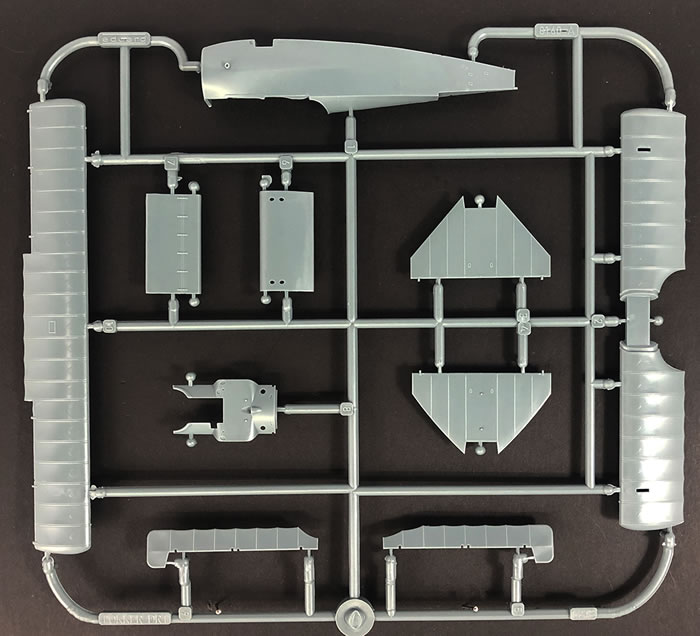
Sprue A has 10 grey injected moulded parts of which 2 are not used, including a tail plane and an aileron for another version. Found here is one of the detailed fuselage halves, upper and centre wings, top forward deck, tailplane and undercarriage support winglet.
Sprue B
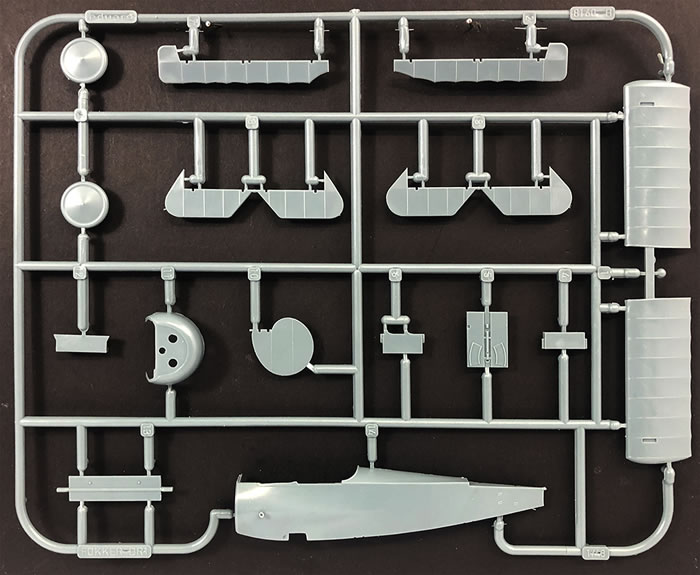
This sprue offers up 11 parts, 2 of which are not used, and which are the other fuselage halve, lower wing, engine cowling, other aileron and tailplane. Parts also include the cockpit floor, rudder and the wheels. All parts are cleanly moulded and have little to no flash or mould marks on the whole.
Sprue C
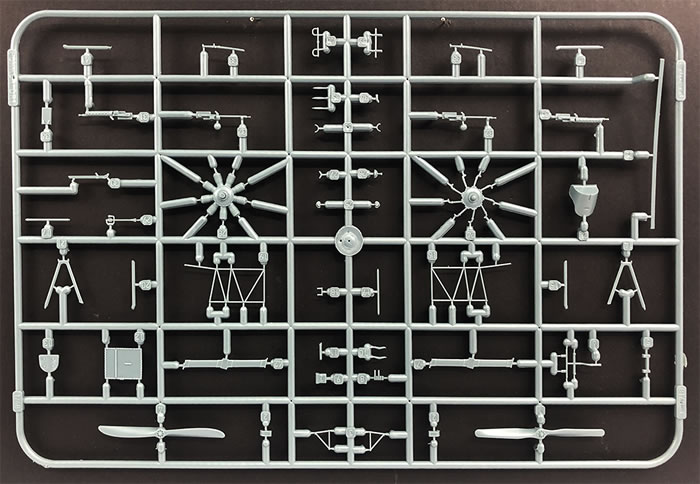
This sprue has 52 parts on it with only 4 parts which are not used, and which are the remaining parts of the aircraft. Parts here include the remaining cockpit parts, all the struts, engine parts and the guns. All parts are cleanly moulded and have little to no flash or mould marks on the whole but the struts do have some minor flash. There is lovely detail with the engine cylinders as well as 2 excellent propellers, but only one is used on this version. It’s just waiting for an awesome wooden paint job….good luck.
Instructions and Decals

The instructions for the kit are the usual Eduard, with a glossy booklet of 12 A5 pages of high quality detailed instructions, with copious colour call outs throughout, using the Gunze Aqueous, Mr Color as well as the Mission Models range.
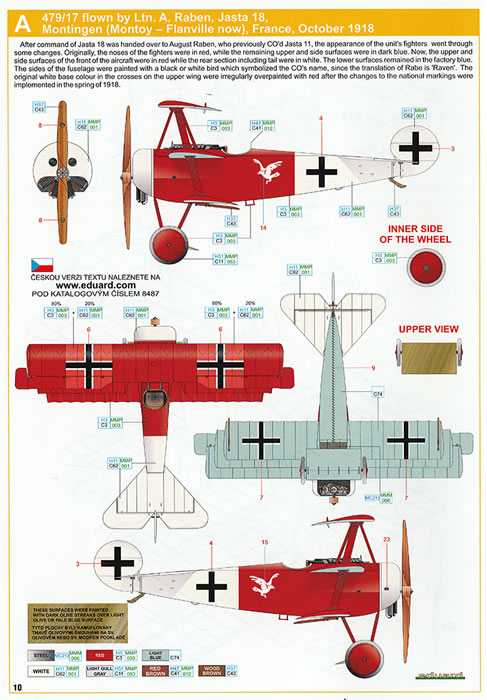
The decals are printed by Eduard and appear to be in perfect register giving the options for 2 different aircraft.

They are:
- Fokker Dr.I, 479/17, Lieutenant A. Raben, Jasta 18, Montingen, France, October 1918
- Fokker Dr.I, 503/17, Lieutenant Hans Körner, Jasta 19, Balatre, Belgium, April 1918
Eduard has again produced a nicely detailed, yet fairly simple kit of the Fokker Dr.I in their Weekend Edition range.
Despite not having the bells and whistles resin, etch and masks, this kit will build into a very high quality model and certainly will bring some brightness to your model cabinet with the great colourful schemes. My research has found that this re-released kit has a flaw in that its undercarriage struts are too long so the aircraft sits with too high a nose position. I’m sure this could be corrected with some simple surgery. A highly recommended kit for the beginner or experienced WWI modeller.
Thanks to Eduard for the sample
Review Text Copyright © 2020 by David Couche
Page Created 29 June, 2020
Last updated
29 June, 2020
Back to HyperScale Main Page
Back to Reviews Page |
